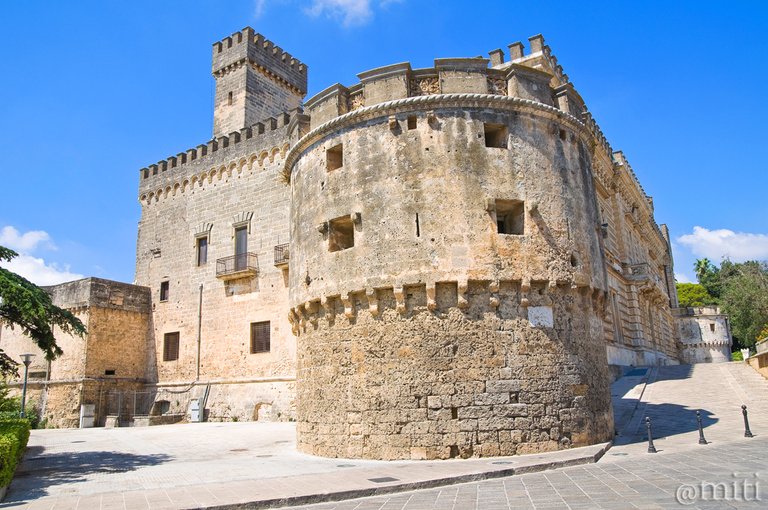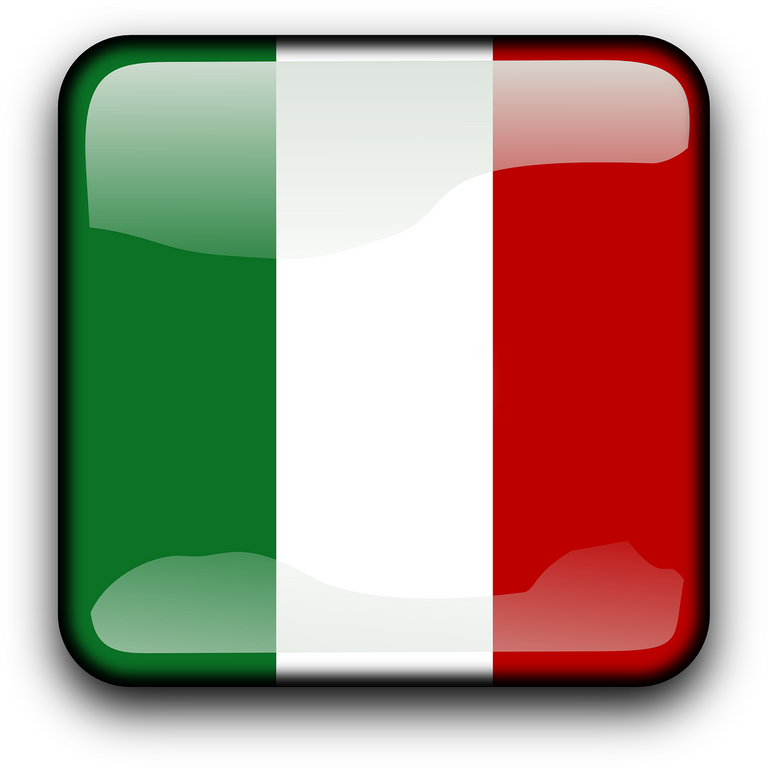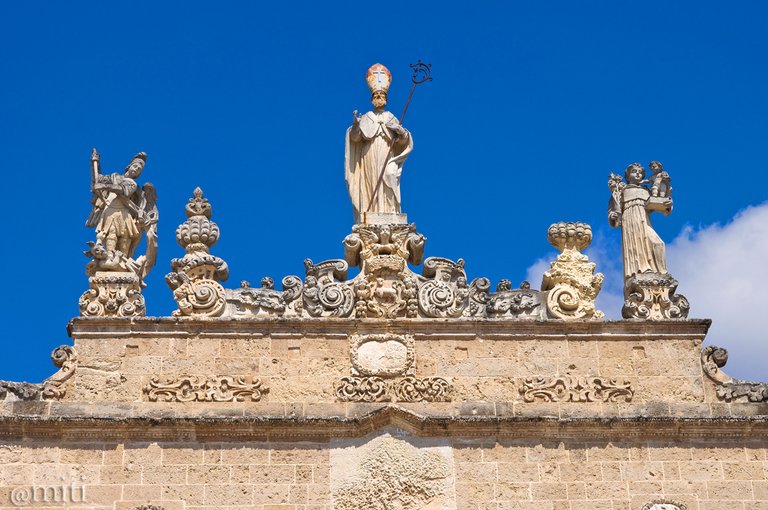
Il castello Aragonese (Immagine dell'autore - tutti i diritti sono riservati)
The Aragonese Castle (Author's photo - All rights reserved)



Ciao a tutti,
questo è un viaggio attraverso l'Italia. Posterò una foto al giorno con una brevissima descrizione.
Spero vi piaccia!

Nardò è un comune della provincia di Lecce, nella regione italiana meridionale della Puglia. Originariamente città romana "Neretum", era sia bizantina che normanna.
Ci sono varie ipotesi riguardanti la fondazione di Nardò, ognuna con un supporto archeologico. Una è che fu colonizzata dai migranti cretesi intorno al 3000 a.C., un'altra suggerisce che gli egiziani fossero i coloni originari. Tuttavia, rimane inconfutabile che, 1.000 anni prima di Cristo, fu una fiorente comunità messapica, che in seguito passò all'influenza greca sotto il controllo della potente colonia di Taranto.
Come la maggior parte delle città e degli insediamenti della Puglia meridionale, partecipò alla consueta giostra di dominatori tra Saraceni, Normanni, Svevi, ancora Saraceni, pontefici, Aragonesi, Veneziani insieme a numerosi altri re, principi, sultani e usurpatori che combatterono per la supremazia, per poi perderla nuovamente quando la sovranità della passava al successivo usurpatore.
I monumenti più importanti che meritano una visita a Nardò sono la Piazza Centrale che contiene la famosa Fontana del Toro, così come il Palazzo Salandra della Pretura, il Palazzo del Sedile, il tempietto de l'Osanna e la Chiesa di San Domenico risalente al 1500 . A poca distanza si trova la bella cattedrale gotico-romanica con un interno risalente al 11 ° secolo, ma che rinnovato la facciata in stile barocco dopo il terremoto.
Il Castello Aragonese di Nardò, costruito dalla famiglia Acquaviva del XV secolo, è grande e imponente; oggi il suo ampio recinto murato e recintato ospita il Municipio e le infrastrutture comunali dell'ammistrazione che comprende la giurisdizione dei tre borghi marinari di Santa Maria di Bagno, Santa Caterina e Santa Isodoro. Il litorale per il quale Nardo ha vinto vari premi ambientali, comprende numerose torri di avvistamento fortificate risalenti al Medioevo e ai tempi successivi, oltre a comprendere le aree del meraviglioso Parco Nazionale di Portaselvaggio.
Oggi il famoso circuito di Nardò sito nelle vicinanze e viene utilizzato come pista di prova per la guida ad alta velocità.
Da vedere: Il centro storico, la Cattedrale Gotico-Romanica, il Castello Aragonese, il Palazzo Salandra, la Fontana del Toro, il Palazzo del Sedile, il Tempio de l'Osanna, la Chiesa di San Domenico, la Chiesa del Carmine, la Chiesa di San Cosimo, il circuito di Nardò.

Hello everyone,
I began a Photo Journey through Italy. I will post one photo every day with a little note of explanation. I hope you like it!

Nardò is a town in the province of Lecce, in the Southern Italian region of Puglia.
Originally the Roman city of Neretum, Nardò was both Byzantine and Norman.
There are various hypothesis’s regarding the founding of Nardo, each having some archaeological support. One is that it was settled by Cretan migrants approx 3,000 BC, another suggests Egyptians were the original settlers. However, it remains irrefutable that by 1,000 years before Christ, it was a thriving Messapian community, later passing to Greek influence under the control of powerful colony of Taranto.
Like most cities and settlements of Southern Puglia, it participated in the customary merry-go-round of ownership by Saracen, Norman, Swabian, Saracen (again), Papal, Aragonese, Venetian overlords along with numerous other Kings, Princes, Sultans and usurpers who first fought for supremacy, only to later lose it again as sovereignty of the town passed to the next aggressor.
Most notable sights worth visiting in Nardo include, the Central Piazza which contains the famous Fountain of the Bull, as well as both the Palazzo Salandra of the Pretura, the Sedile Palace, the small temple of Osanna and the San Domenico Church dating from the 1500’s. Just a short distance away is the beautiful Gothic-Romanesque Cathedral with an interior dating from the 11th century but which received a Baroque facade after the earthquake.
The Aragonese Castle of Nardo constructed by the 15th century Acquaviva family, is big, imposing and impressive, today its extensive walled and gated compound houses the Town Hall and Municipal infrastructure of the Comune which includes the jurisdiction of the three seaside villages of Santa Maria di Bagno, Santa Caterina and Santa Isodoro. The coastline for which Nardo has won various environmental awards, includes many fortified lookout towers dating from Medieval and later times, as well as incorporating areas of the stunning Portaselvaggio National Park.
Today the famous “Nardo Ring” testing track, the first of its kind in Europe, is located nearby and is used as a test track for driving at high speeds.
Thing to see: The historical center, the Gothic-Romanesque Cathedral, the Aragonese Castle, the Palazzo Salandra, the Fountain of the Bull, the Sedile Palace, the Temple of Osanna, the San Domenico Church, the Church of Carmine, the Church of San Cosimo, the Nardo Ring.

| Tipo di foto / Category | Paesaggio / Landscape view |
| Esposizione / Settings | 1/250 sec, ISO 200, f/10 |
| Camera | Nikon D5000 |
| Lente / Lens | Tamron SP 17-50mm f/2.8 XR Di II LD |
| Filtro / Filter | Polarizzatore Hoya / Hoya Polarizing filter |
| Cavalletto / Tripod | Manfrotto MKC3-P01 |
| Località / Location | Nardò (Lecce), Italia |
| Software | Photoshop |


Palazzo del Sedile (Immagine dell'autore - tutti i diritti sono riservati)
The Sedile Palace (Author's photo - All rights reserved)
I always like historical places. Seems this is one of those. Nice picture. Thanks for sharing.
Yeah, this is a place with an age-old history.
Il castello è bellissimo, anche se sembra piccolo.
Lo scatto inganna, non è così piccolo come sembra..
Una delle poche mete della Puglia che conosco bene.
Spesso ho visitato la città per questioni sportive.
Bella tradizione di basket.
Ah vedi, questa non la sapevo! Questa volta sei tu che hai insegnato qualcosa a me :-)
italy has got lots of natural and manmade wonders. really liked your post thanks for sharing
You are welcome!
Nardò mi suonava familiare... infatti l'anno scorso ci siamo passati vicino.
Alloggiando a Marina di Ugento, abbiamo visitato Gallipoli, Otranto, e Santa Maria di Leuca.
Quest'estate replicheremo e, grazie alle tue graditissime schede illustrate, saremo più preparati... vero Carlo? ;)
Un caro abbraccio da @amico!
Bellissima zona, quella che hai citato.. mare e località dalla storia antica. Ti prometto che proporrò altre "schede illustrate" della zona così visiterete altri bellissimi posti. Un abbraccio a te ;-)
Sei gentilissimo, Carlo: grazie mille!
Today's and day 47 post have covered towns from the Lecce province. I get the impression that this province has a particularly rich history.
As I can also see that Nardo has an especially ancient cultural significance. If the fist settlements go as far as 3000BC then it would be just after the early Mesopotamia and Indus valley time periods.
The history is beautifully offset by the modern facility like the Nardo Ring. Internet also had some truly beautiful pictures of this ancient town.
The Salento Peninsula has a very age-old history. Even two hundred of kilometres away, I often go there.
Thanks for sharing the settings you used on these photos. Love the architecture there.
You're welcome ;-)
Its a nice place...really enjoyable to spent sometimes there
Yes, it is!
well i have been to this place and i agree with you this is like heaven on earth.
Wow Italy picture look great, sadly i cant read the article
Why can't you read the article? It's both in english and italian language..
don t get bothered with the article. the pictures say it all.
LOL, it's pretty right! ;-)
my foto
Your comment is considered SPAM... Take a look in this guide:
https://steemit.com/steemit/@miti/a-complete-guide-for-newcomers-and-minnows-to-avoid-a-possible-spam-and-to-write-good-comments
It will help you.